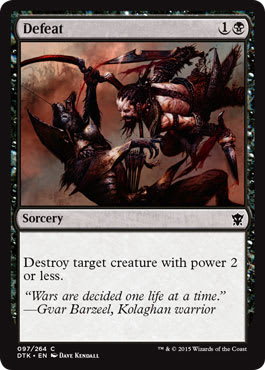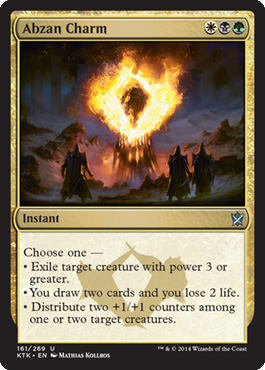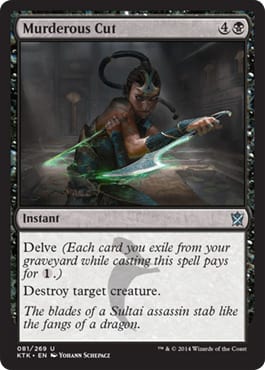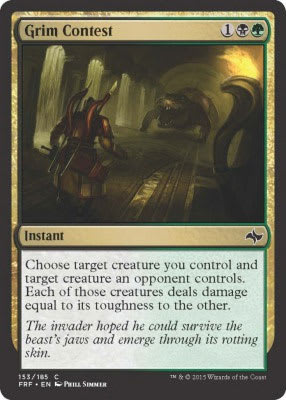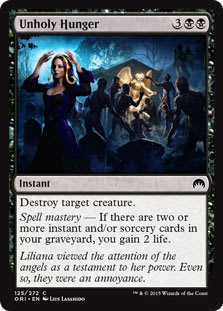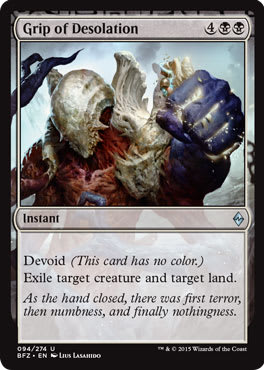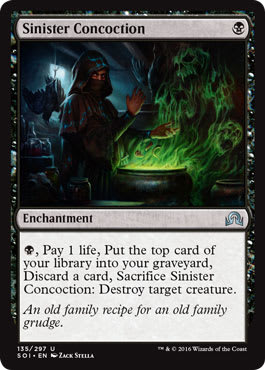As before, I’m limiting my look to cards that make up the rank-and-file environment of a given set or block, and that means commons or uncommons. The fact that rare cards are, in fact, rare, means they tend to overshadow the cards actually doing most of the work in the set environment, while actually being a comparatively narrow element of it. If you want to get a sense of what life in ancient Rome was really like, you don’t spend your time gawking at the Senate. The same applies here.
Throughout this series, we’ll be looking particularly closely at the “knobs and levers,” the things Wizards R&D can do to adjust the power level and effects of cards one direction or another. For Black removal, these include:
- Mana cost. Although one of the most obvious of a card’s characteristics, this remains one of the most important to the notion of “playability”
- Dedication. Related to mana cost, how much Black mana do you have to have at your disposal to reliably cast the card? Can you splash the card, or do you need to be heavily in Black?
- Speed. When can the card be played? During our main phases only (slow), or during an opponent’s turn as well (fast)?
- Versatility. What can this card deal with? While ultimately the answer is “creatures,” the selection can widely very. Big creatures? Small creatures? Expensive creatures? Cheap creatures? Creatures of particular colors?
- Additional effect. Once upon a time Stone Rain existed. Wizards determined that this was an unfun and imbalanced strategy, but rather than remove it from the game, they moved the cost to where it would be adjudged ‘fairer’ (see:Craterize) or tacked on added effects that pushed the cost up (see: Poison the Well). What sort of riders have these removal cards been given?
Now, let’s head to Tarkir!
Khans of Tarkir Block (2014-15)
Just like Return to Ravnica Block expanded the library of Black removal two years prior, Khans of Tarkir block similarly elevated the quantity of removal sloshing around its environment. This wasn’t a coincidence. Rather, both were multicolored sets, so you not only have to break out removal by a single color, you also have to explore the design space at the intersection of different color pairings/groupings.
You’ll recall that we saw removal options on the Dimir and Orzhov Charms, so it’s little surprise that we see it again in the latest iterations. While the Dimir Charm destroyed a smaller threat, the Abzan Charm has loftier ambitions, exiling a creature with a power of 3 or more. The Sultai Charm was a bit narrower, destroying a mono-colored creature, which is cold comfort in an environment where multicolored beaters like Siege Rhino are the norm. Finally, the Mardu Charm is less “Black removal” than “removal in Black,” since its removal option (4 damage) reflects the Red aspect of the card, with Black contributing a Duress.
As for the more traditional forms of removal, as expected from the first set of a new block, you get a little bit of everything. Dead Drop checks the ‘Edict’ box, almost forcing players to make use of the delve mechanic to render it even remotely palatable. Delve also finds its way onto the standard-issue death spell, Murderous Cut. Coming off of the long night of weak Black removal in Theros block, Murderous Cut was no Doom Blade, but under the right circumstances you could frequently make it even better. You just had to jump through the hoop of stocking your graveyard first.
If Murderous Cut was too good for you, you could always challenge yourself to run Rite of the Serpent, a wonky, 6-mana sorcery with art reminiscent of the old Miracle Worker. The upside to running such a bloated spell is that if your target happened to be sporting a +1/+1 counter, yay, free Snake! Whether it was a hedge against an overpowered outlast mechanic or a plant in anticipation of the third set’s megamorph mechanic, the world may never know.
Finally, Khans offered a pair of Black debuffers in Debilitating Injury and Throttle. Both of these showed the set’s vision of debuffing spells as slightly worse than what had come before. Debilitating Injury was simply a Dead Weight that cost ![]() more, while Throttle, on first blush, looked terrible for those who enjoyed playing Grasp of Darkness. Why the change?
more, while Throttle, on first blush, looked terrible for those who enjoyed playing Grasp of Darkness. Why the change?
The answer to that is likely a shift in design philosophy for the limited game. An abundance of cheap, common removal ensures that drafts often come down to bloody slogs, where everyone’s best cards are killed off and they’re left sending in the leftovers. By making removal a more deliberate and pinpoint option, it allows for a little more nuance in the game. A card like Throttle still does what it was intended to do, kill things, but it won’t necessarily be an automatic windmill slam of an early pick, and you won’t see such a momentum change in the game as you might with cheaper removal. Killing your opponent’s bomb and playing your own at the same time was a massive swing; now, with Throttle in your hand, you’ve got a tactical decision to make: which one to play?
In other words, removal should be about supplementing your existing strategy, rather than being a core component of it. If we’ve seen one major change across the face of removal in the past seven years we’ve covered with this article series on Gathering Magic, that’s the one.
Fate Reforged didn’t upset the apple cart, but did give us a few more tools for the toolbox. If you were looking for a card to symbolize the paradigm shift in progress as detailed above, Reach of Shadows would be an excellent candidate. It’s a common kill spell, so you could expect to play around these in limited. It cost 5 mana, the same as Murderous Cut did sans any cost reduction. And its removal was broad, but not unconditional, unable to impact something like an artifact creature or 2/2 morph token. Good, but not too good; useful, but not too useful.
After a few years of bouncing around with cards like Sorin's Thirst and Last Kiss, Wizards opted to just reprint Douse in Gloom this time around. Grim Contest was simply a fight enabler that probably could have been just fine fully in Green, while another multicolored card, Harsh Sustenance, rewarded you for having assembled a vast army.
Another interesting example of removal reflecting the environment comes to us in Dragons of Tarkir. The printing of Flatten caused some folks to scratch their heads, coming so soon after Throttle. Both did the same thing, at the same speed, and yet one was cheaper than the other. What changed?
In short, Dragons. The iconic tribe was the big push of Dragons of Tarkir, and with large, evasive beasties abounding, development felt that the environment needed to be a touch more aggressive with its removal. Remember, too, that Dragons of Tarkir was not meant to be drafted with Khans of Tarkir, so there was no overlap between the two cards beyond “appearing in the same block together.”
Of course, not unlike what we’ve seen in sets that want you to play larger creatures, the removal is adjusted to reflect that. Death Wind can kill anything, but it can command a rather hefty price tag in mana for doing so. Defeat is cheaper, but limited to smaller creatures. Ultimate Price, with its limitations against multicolored creatures (which many of the Dragons were), makes an appearance here, following its initial printing in Return to Ravnica.
Non-targeted removal was represented by Foul-Tongue Invocation and Self-Inflicted Wound. As with all Edict effects, it can take some doing to find the optimal time to play them for the best effect, but the tradeoff is that they tend to be relatively inexpensive ways to kill things. As I said in the outset of this series, removal really does tell a story about the environment it’s in, and in a block like this that’s especially evident.
Magic Origins (2015)
Sadly for some, Magic Origins represented the last of the great, modern-era Core Sets begun in 2009 with Magic 2010. In their time, these Core Sets helped redefine the game of Magic in a way the previous biennial, all-reprints sets never really could. With their black borders, returning mechanics, and wealth of new cards (even if many were just functional reprints), they filled their function well, but couldn’t withstand the pressure of a reformed block structure. Something had to give, and it was the Core sets that gave most.
So what sort of removal did Origins give us as the final hurrah? Those hoping for one last look at Doom Blade were certainly disappointed, as Doom Blade seems to have gone off to join Terror in that great Black removal convention in the sky. In fact, Origins didn’t even bring back Murder (we wouldn’t see that again until Eldritch Moon). Rather, it simply reprinted the kill spell from the last Core Set, Magic 2015, with Flesh to Dust.
But just as Magic 2015 had signaled a break in the Core Set continuity (as touched on in the previous article, Magic 2015 ran a mostly-new suite of spells rather than just “plussing over” the previous year’s package with a few revisions/reversions, as had been the norm). Covenant of Blood could not have been reprinted, since it played with the returning mechanic of Magic 2015, convoke. But aggressive options like Stab Wound or Ulcerate were gone, as was Crippling Blight.
Instead, there seemed to be a reinforcement of the five-mana price point for removal. In addition to Flesh to Dust, we also got Unholy Hunger. The two could almost have been the same card, serving the same primary function at the same speed, cost, and commonality, but for a lifegain rider on the latter versus the anti¬-regeneration clause in the former. Although regeneration has been on the wane for some time, the ability to stop it was still at least modestly relevant in Origins, due to Undercity Troll, Dark Dabbling, and Consecrated by Blood. Corner case, sure, but at least there’s a case.
If that’s not enough five-mana removal spells in the set for you, take heart that there’s also Cruel Revival. This tribally-flavorful uncommon gave you the same anti-regeneration ability as Flesh to Dust, with a slightly narrower targeting profile (no Zombies). In exchange, hey, you win a Zombie card from your graveyard!
From there, Weight of the Underworld was brought back from Born of the Gods as the go-to Black enchantment removal for the set, while Reave Soul gave us a less-pricey option for dealing with smaller, nettlesome creatures.
Battle for Zendikar Block (2015-16)
Not since the original Innistrad in 2011 did we see a first set with such slim pickings for Black removal in terms of quantity of cards. Bone Splinters was back, last seen in Avacyn Restored, and could destroy most anything at the cost of one of your own creatures. Demon's Grasp was another twist on Throttle, costing the same as that much-maligned spell, but doing even more work (-5/-5) at a tradeoff for speed (it’s a sorcery).
Adding in the devoid cards doesn’t get us much further. Complete Disregard exiles a creature with power 3 or less. Grip of Desolation, meanwhile, was a functional equivalent to Journey into Nyx’s Spiteful Blow, with devoid tacked on to give it the “otherworldly Eldrazi” feel.
So where was the good removal? Sure, Ob Nixilis Reignited had a “destroy target creature” mode, but the real answer lies in the return of Hero's Downfall. Hero's Downfall, from Theros, was noteworthy in that it not only could target creatures, but it could snuff out a Planeswalker as well. For Battle for Zendikar, Wizards brought it back as Ruinous Path, adding on the set’s awaken mechanic and downgrading it from an instant to a sorcery to preserve cost balance. As a rare, you couldn’t count on seeing it often at the draft table, but it was the best the set had to offer.
Sadly, Oath of the Gatewatch offered us little more, and both of these removal of the debuff variety. Tar Snare gave a -3/-2 debuff for 3 mana, while, wouldn’t you know it, Grasp of Darkness made a triumphant return. After all the convolutions the spell type had gone through since its printing in 2010, it was back in its original, ![]()
![]() form.
form.
Devoid comes to the rescue here again, with the superb Oblivion Strike. For just 4 mana (and only one of them Black), you could exile any creature. Since it’s exile, that essentially gets around any regeneration shenanigans, and the target was gone for good.
Shadows over Innistrad Block (2016)
All of this brings us to our present block, leading with Shadows over Innistrad and concluding with Eldritch Moon. While Shadows kept the removal-light tone of the previous block, Eldritch Moon has delivered hope for better days to come.
Almost as if to prove that R&D has a sense of humor, Shadows over Innistrad brought back poor Throttle one set after Grasp of Darkness returned. Dead Weight made a comeback from the original Innistrad to an environment where it was even more useful, offering enchantment-based removal in a set that cared about card types (thanks to delirium).
Death Stroke got an update in the strictly-better Murderous Compulsion, which simultaneously made the card easier to cast and upgraded it with madness. Finally, R&D hit a flavorful grand slam home run in our last bit of removal, Sinister Concoction. Designed to emulate the “witches’ brew” trope (eye of newt, etc), Sinister Concoction led you on a merry chase of costs that only just started when you put into play, but paid off in the destruction of a creature.
What made Sinister Concoction work best was just how it integrated with the set’s mechanics, as each “cost” aside from the mana and life investment was an opportunity to wring even more utility out of the card. Having a discard outlet is a bonus if you’re running madness, and milling a card off the top of your library for delirium is perfectly welcome, not least because you’d also be sending off the enchantment itself when you popped it. The way it wove all of these elements together into a flavorful and useful whole made Sinister Concoction one of the best-designed cards we’ve looked at in the last couple of weeks.
But even a clever card isn’t enough to give Shadows over Innistrad high marks for removal, but moving on to Eldritch Moon shows some real growth. For one thing, cheap, fast removal is back in the form of Murder, last seen in Magic 2013. Sure it’s moved up to uncommon from common to better reconcile it with R&D’s modern removal sensibilities, but for those who have been getting by with Flesh to Dust, the difference is significant.
Those pining for the days of five-mana removal won’t be let down, either, with fellow uncommon Ruthless Disposal. Not unlike Sinister Concoction there’s a bit of a price to pay beyond the card, but being able to take out two different creatures in one go is not to be sneered at. For something a little more conventional, there’s Certain Death, which fuses together (or melds) removal and Syphon Soul. Boon of Emrakul is aura-based debuff, while Borrowed Malevolence offers a small dose of debuff paired with the new escalate.
The Future
If this was 2011 and you were standing at the far end of Scars of Mirrodin block after Magic 2012, you might be forgiven for feeling pretty optimistic about the state of Black removal as you approached a gothic-horror-themed set, Innistrad. Instead, as we’ve seen, Innistrad ended up initiating a darker time for the archetype, and the lesson there is that you can’t draw much of a conclusion from a fixed moment in time.
Nevertheless, while we may not be able to read much of the state of Black removal in Kaladesh from what we’re seeing in Eldritch Moon, this will be the first Summer in the modern era to skip a Core Set and go right into the next block. From Doom Blade to Murder to Flesh to Dust, while the cost of removal has crept steadily upwards overall, the Core Set has often been the place to lay down a bedrock for the “expert-level sets” to rest upon. With the move to the two-set block model, that bedrock is gone, and each set will have to lay its own foundation not only for itself, but for the block to come.
I hope you’ve enjoyed this walk through the halls of time for a single aspect of Magic: the Gathering. And this was just for one aspect of the game. As I wrote in the beginning of the series, one could do just as detailed analysis of the development of Blue card draw or Green pump spells. Sometimes tugging at a single thread gives you a sense of the depth of the tapestry, and that’s no exception here. It might help to remember that if the removal suite in Kaladesh is weak, that’s because some other elements of the set need the ability to fully express themselves. Finding out what those are is half the fun.
It’s always fascinating to explore the larger context and deep history of the game, and I would certainly encourage anyone, as the spoilers for Kaladesh soon start trickling in, to spare a thought for the incredible complexity and difficult work Wizards R&D does designing this game we love, a game going strong after two decades of existence.
Thanks for joining me. I’ll see you next week when we begin meddling the Eldritch Moon Intro Packs.














